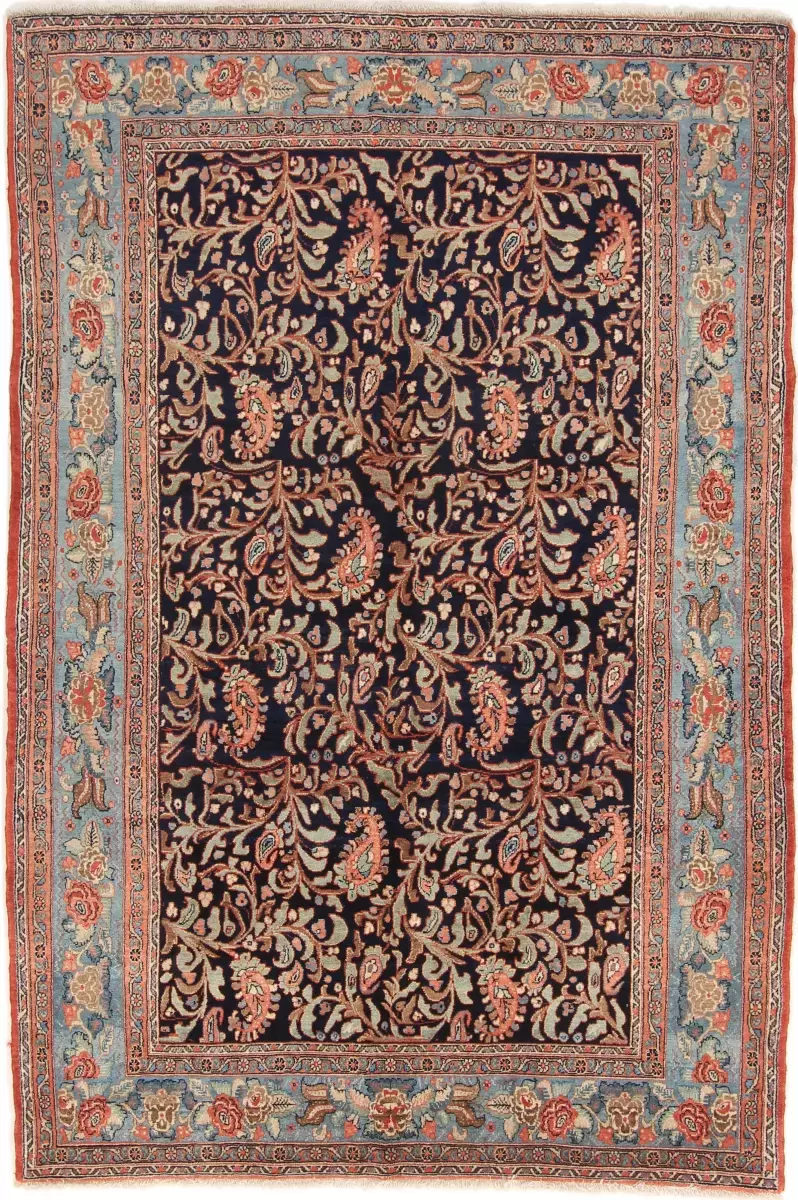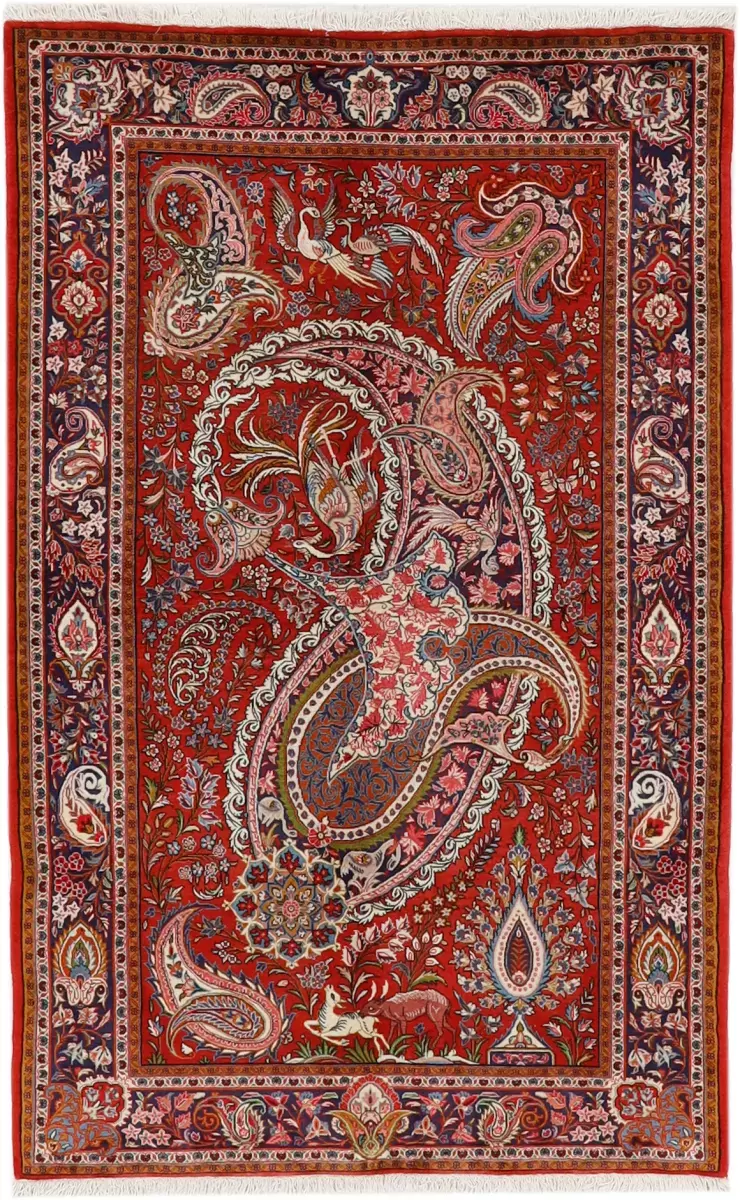The role of Boteh Jeghe and its types in Iranian handwoven carpets
Boteh Jeghe is one of the original Iranian motifs, which is used in many other traditional arts of Iran, such as needlework and jewelry making, in addition to carpets. Boteh Jeghe is a royal symbol that refers to steadfastness and immortality. Carpets with the Boteh Jeghe pattern are woven in many parts of Iran, including Kurdistan, Sarouk, Farahan, Qashqai tribe, etc., and the motifs of each region have their own characteristics. In this article, we are going to introduce the beautiful pattern of Boteh Jeghe on Iranian carpets and its types.
Introduction of the role of "Boteh Jeghe"
"Boteh Jeghe" motif is a motif that is used in the Iranian carpet art of the Islamic period. The history of using this role in Iranian art has always been discussed. A group considers this motif to be an Iranian motif that was born from pre-Islamic decorations, such as the cedar tree or animal wing motifs of the Sassanid period. On the other hand, the other group considers it as a motif that was introduced to Iranian art through Indian Kashmiri shawls. Boteh Jeghe motif is one of the most popular motifs among weavers. In most cities of Iran, the motif of Boteh has decorated carpets and rugs. This role has been used more than any other region in Fars nomadic handlooms, such as Boulevardi and Qashqai carpets. But in other places such as Bijar and Hamedan and among the Turkmen nomads and Kurds in the western regions of Iran, it is also popular and accepted. More than seventy classified categories have been reported in relation to the role of Boteh Jeghe; While only nearly twenty groups have been mentioned with precise names in various sources. Due to the wide variety of different types in each group, the wide variety of motifs of Boteh Jeghe is over dozens of diverse examples. The application of Boteh Jeghe motif is not only as a decorative motif but also as a basis in the formation of some maps.
What is the symbol of Boteh Jeghe?
Bute or Boteh, which is called "Boteh Jeghe" in the common term, can be seen as a symbol of combining art and thought. A group of semiologists consider it a symbol of the tree of life or cypress, which is the basis of a new composition. The existence of the concepts of immortality, youth and immortality in the semantics of the tree of life and the symbol of its species "cypress" may not have had an influence on the formation of this motif. By preserving its identity and symbolic meaning, this idol has been able to change its shape and produce works of art in different regions. The existence of more than seventy different types of Boteh motifs clearly defines the deep and symbolic roots of this motif.
The background of Boteh Jeghe motif in Iranian carpets
From the twelfth century onwards, in terms of the expansion of business relations and the application of the opinion of merchants, this role was used as a decorative image to decorate carpets; In such a way that today its various types are known under different titles, such as Boteh Miri, Boteh Badami, Boteh Jeghe and Boteh Tarmei under the title of velor, Bardaran, two heads, Tajdar, Kalamkar, Jiwanei and other types, such as Boteh Jeghe Saad, Chicken head, We see the Shali Boteh, the Dagger Boteh, the Flowered Boteh, the Cluster, the Gabadkhani, the Mahramat Boteh, the Left and the Right Boteh, Kahr and Ashti, Boy and Girl, Hasht Goli, Deer Horn, and the Almond Boteh.
Types of motifs
The idol group has been divided based on the place of use. Among them, we can refer to Boteh Qashqai, Boteh Mughan, Boteh Sefe. Another group has classified Boteh based on their symbolic concepts, such as the Boteh of wrath and reconciliation, the Boteh of the tree of life, the Boteh of the mother of the child. Other carpet experts have divided it due to its size and the way it fits in the whole design, such as Boteh Jeghe and it is known as "Boteh Mir" because it is from the Malmir region of Arak. Boteh Jeghe is a motif that can be seen in many areas of carpet weaving in Iran and each region has its own characteristics. The smallest Boteh painting is called Boteh Jeghe (Boteh Mir). Among the types of idols that are bigger than Jeghe idols, the motifs of Qabadkhani or Qabadi idols, Fath Ali Shahi idols in Kurdistan, Damjani idols and Tak Boteh in Ghiyath Abad, Arak (Sarouq), and eagle or nest idols and mother and child idols are more common.
How to use the Boteh pattern in the carpet
Boteh is used in different ways on the carpet text. In principle, rugs with a Boteh design do not have fringes, elastics, and fringes. Besides, the collars are of the same size, the same color, and are woven in regular and parallel rows throughout the text. Like the entwined fish pattern, at first it is an all-over design and it is woven without the use of thread and lace by placing the Botehs in parallel horizontal or oblique rows. Since the weavers are always looking for variety of design and avoiding uniform designs, they reduce the boring monotony of identical and same-colored rows of Boteh Qabadkhani at the beginning by means of impressive borders. After some time, the technique of various coloring of Botehs was combined with the method of placing repetitive motifs in oblique rows, and this was the beginning of the golden age of Botehs. From the end of the 13th century, very small laches were introduced little by little with great care. With the gradual growth of laches, bergamot gradually gave way and this was the beginning of decline. The use of elastics was expanded to such an extent that idol motifs remained as a secondary and luxurious image.

Classification of Iranian carpets with Boteh Jeghe pattern
Some of the maps that show the general shape of the Boteh placement in the carpet text are known by special names, among which the following types can be mentioned:
1. Boteh map: a map that is considered one of Shah Abbasi's secondary plans. In this plan, Boteh's paintings have a special place. Botehs are depicted in usual forms in combination with lifeless and slimy foliage and other Shah Abbasi paintings. A plan that is mapped based on the types of Boteh is called that Boteh.
2. Boteh Lakh toranj: it is a common and prolific map in Kerman; A combination of Boteh's motifs and motifs, Lakh and Tareng, Slimi and Khataei frames, Shah Abbasi leaves and flowers, and combined flowers from Bethe's motif. This kind of Kermani-style mapping of Boteh design is also called "Lechak toranj" which is influenced by the traditional art of Pate Douzi. Examples of it can be seen in Qashqai carpets.
3. Boteh with Alvan background: Boteh design in which the background of one or a row is in the form of parallel lines of pictures in a special color. This type of map is considered as one of the mahramat designs and it is located in parallel lines along the length of the carpet.
4. Hasht Boteh: a design based on the repetition of Hasht Boteh or Kurdistan Boteh. This map is also called the Kurdistan idol plan. This pattern consists of eight small Botehs (almonds) in the shape of a circle, which is repeated throughout the text.
5. Twin Botehs: two Botehs that are joined at the base and are mostly seen in the edges of carpets. In some cases, the number of Botehs has increased and they have been used in the corners of the carpet, such as triple Botehs.
6. Sarham Sawar Botehs: In this design, one of the Botehs is carved on the other Boteh in a part of its body in such a way that it seems that both have the same base.
7. Mother and child idols: the role of two idols, one big and the other small, where the little one takes its head from inside or next to the big one, and their heads are in the same direction. The basis of the design of the idols of mother and child are these pictures.
8. Mother of twin children: In this role, one large mother can be seen, and two small and stuck together like two twin children, and the big mother, the mother, is surrounded by the twins.
Dispersion of Naqsh Boteh in different parts of Iran
In Saraband, most of the carpets are woven with a Boteh design, which is the same as the Mir Boteh, and in Sanandaj and Qaynat, the weaving of a cloaked Boteh design is very popular. Naqsh Boteh is also common in the western region of the country. In Bijar, this pattern is seen as a leafy sub-painting as the main pattern. In Zanjan, they use it in a coarse and rough manner, with inspiration from the role of Boteh Bijar. Farahan, Malair and Sarouk also use the role of Boteh a lot. In Hamadan, this role is also woven as a secondary project with specific regional measures. Boteh pattern in simple form and dotted or flowered lines under the name of Qabadkhani is typical of southern nomads and especially of Fars, which along with star motifs and pleasant colors adorns the textiles of the region.
Final word
The role of Boteh Jeghe has a valuable place among Iranian weavers. Almost all carpet and rug weavers have used this pattern. In fact, the degree of acceptability of Naqshmayeh is so much that it has been used in both carpet decorations and carpet motifs and even types of needlework and weaving. According to some reports, more than seventy different types of this motif are known in different parts of Iran; But most of the researchers have mentioned about twenty types of this role. The motif of Boteh Jeghe is used both as a decoration and as a basis for arranging a map in the text of the carpet; such as Boteh Jeghe carpets in Saraband and Sanandaj. The most use of the Boteh-jake motif is observed in Qashqai and Boulvardi handwovens. In these handlooms, NaqshBoteh has become highly abstract and has progressed towards becoming geometric. Among other regions that pay attention to the role of Boteh Jeghe, we can mention the carpets of Qom, Kashan, Kerman, Fars, Kurdistan and Arak. Finally, it should be said that the motif of Boteh Jeghe on the hand-woven carpet is rooted in the beliefs of ancient Iranians and is a symbol of steadfastness and immortality.
You can inquire about Buying Handwoven Carpets , Buying Handwoven Kilim and Mats , and Buying Handwoven Pictorial Rug Tableaus online from the Hoveida Carpet Store and register all your orders and Wherever you are in the world, deliver it to the desired address in less than 4 working days.
If you are interested in reading other articles in the field of Handwoven carpets or Handwoven Pictorial Rug Tableaus , please refer to Hoveida Carpet Commercial .
Leave a comment
Your email address will not be published. Required fields are marked *












